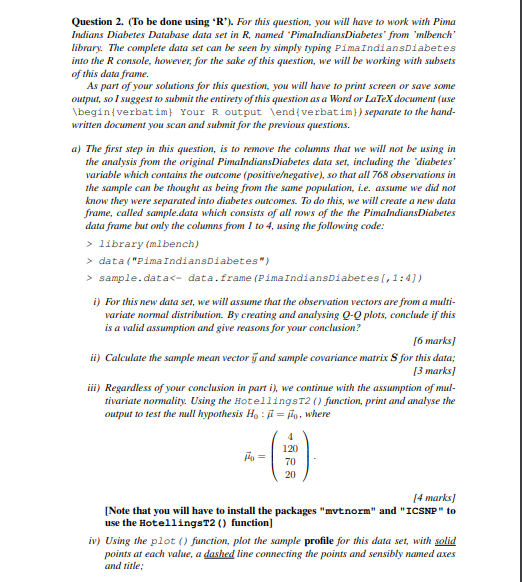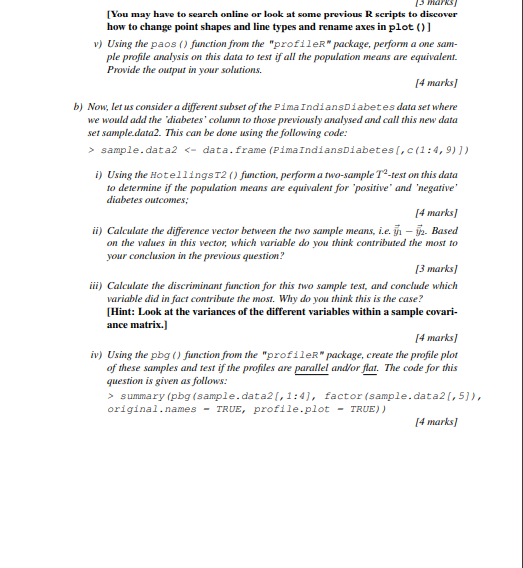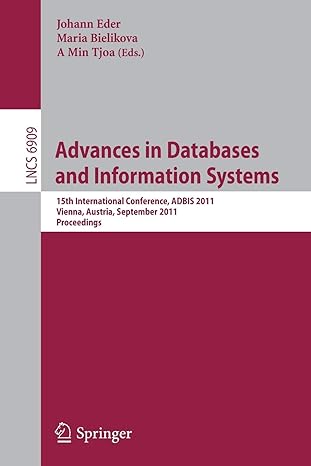Answered step by step
Verified Expert Solution
Question
1 Approved Answer
you answered to this question until part (iv) and you comment to repost it to answer to the rest of the question. thanks Question 2.


you answered to this question until part (iv) and you comment to repost it to answer to the rest of the question. thanks
Question 2. (To be done using "R"). For this question, you will have to work with Pima Indians Diabetes Database data set in R, named 'PimaIndiansDiabetes" from 'mibench' library. The complete data set can be seen by simply typing PimaIndiansDiabetes into the console, however, for the sake of this question, we will be working with subsets of this data frame. As part of your solutions for this question, you will have to print screen or save some output, so I suggest to submit the entirety of this question as a Word or LaTeX document (use \begin{verbatim} Your R output \end{verbatim)) separate to the hand- written document you scan and submit for the previous questions. a) The first step in this question, is to remove the columns that we will not be using in the analysis from the original PimaIndiansDiabetes data set, including the diabetes' variable which contains the outcome (positiveegative), so that all 768 observations in the sample can be thought as being from the same population, i.e. assume we did not know they were separated into diabetes outcomes. To do this, we will create a new data frame, called sample.data which consists of all rows of the the PimaIndians Diabetes data frame but only the columns from 1 to 4, using the following code: > library (mlbench) > data ("Pima IndiansDiabetes) > sample.data sample.data2 summary (pbg (sample.data21,1:4), factor (sample.data21,51), original.names - TRUE, profile.plot - TRUE)) [4 marks) Question 2. (To be done using "R"). For this question, you will have to work with Pima Indians Diabetes Database data set in R, named 'PimaIndiansDiabetes" from 'mibench' library. The complete data set can be seen by simply typing PimaIndiansDiabetes into the console, however, for the sake of this question, we will be working with subsets of this data frame. As part of your solutions for this question, you will have to print screen or save some output, so I suggest to submit the entirety of this question as a Word or LaTeX document (use \begin{verbatim} Your R output \end{verbatim)) separate to the hand- written document you scan and submit for the previous questions. a) The first step in this question, is to remove the columns that we will not be using in the analysis from the original PimaIndiansDiabetes data set, including the diabetes' variable which contains the outcome (positiveegative), so that all 768 observations in the sample can be thought as being from the same population, i.e. assume we did not know they were separated into diabetes outcomes. To do this, we will create a new data frame, called sample.data which consists of all rows of the the PimaIndians Diabetes data frame but only the columns from 1 to 4, using the following code: > library (mlbench) > data ("Pima IndiansDiabetes) > sample.data sample.data2 summary (pbg (sample.data21,1:4), factor (sample.data21,51), original.names - TRUE, profile.plot - TRUE)) [4 marks)Step by Step Solution
There are 3 Steps involved in it
Step: 1

Get Instant Access to Expert-Tailored Solutions
See step-by-step solutions with expert insights and AI powered tools for academic success
Step: 2

Step: 3

Ace Your Homework with AI
Get the answers you need in no time with our AI-driven, step-by-step assistance
Get Started


